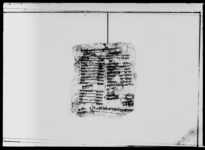A directive to listed persons in Gorkha, Kathmandu and Nuwakot to claim their wheat allowance from the aḍais Rājabala Ḍoṭyāla and Ramānātha Pādhya (VS 1878)
ID: E_2778_0009
Edited and
translated by Surabhi Pudasaini
in collaboration with
Yogesh Budathoki
Created: 2022-07-19;
Last modified: 2022-12-31
For the metadata of the document, click here
The accompanying edition, translation/synopsis and/or commentary are available under the terms of the Creative Commons Attribution-ShareAlike 4.0 International License
Abstract
This directive instructs named persons in Gorkha, Kathmandu, and Nuwakot to claim their wheat allowance from the aḍais Rājabala Ḍoṭyāla and Ramānātha Pādhya (VS 1878).Diplomatic edition
[1r]
1श्री\1मंगल्यानिकापटीके७८सालमहिना४कोसिधागहुं2¯¯¯ ¯¯¯ ¯¯¯ ¯¯¯ ¯¯¯ ¯¯¯ ¯¯¯ ¯¯¯
[table1]
| 1 | गोर्षाजान्या | काठमाण्डौवस्न्या | ||
| 2 | [...] | १के१|१०|• | संज्याराम | १के१|१०|• |
| 3 | [?] | १के१|१०|• | xचन्द्रप्रभा | १के१|१०|• |
| 4 | धनलक्ष्मी | १के१|१०|• | साहु | |
| 5 | पदमा | १के१|१०|• | xचन्द्रप्रभाकोछोरी | १के१|[...] |
| 6 | भागीरथा | १के१|१०|• | xचन्द्रकलाकोछोरीमहालक्ष्मी | १के|१५|• |
| 7 | चामी | १के१|१०|• | xविस्नुधरा | १के१|१०|• |
| 8 | xदेव़रूपा | १के१|१०|• | xइन्द्रप्रभाकोछोरी | १के|१५|• |
| 9 | xविरमी | १के१|१०|• | xसरस्यनाकोछोरी | १के१|१०|• |
| 10 | xधनकुमारि | १के१|१०|• | x अैंजन[...] | १के१|१०|• |
| 11 | xकुट्रु | १के१|१०|• | xविसंधराको[...]भी | १के|१५|• |
| 12 | xलक्ष्मीधरा | १के१|१०|• | xचन्द्रवदनकाछोरामानवदन | १के|१५|• |
| 14 | नुव़ाकोटजान्या | ७८साल[?] | ||
| 15 | xमहारेषाकलस्यानी | १के१|१०|• | [...] | |
| 16 | xचन्द्रवदन | १के१|१०|• | [?] | १के|१५|• |
| 17 | xकासी | १के१|१०|• | [?] | १के१|१०|• |
| 18 | xभक्त्ति | १के१|१०|• | ¯¯¯ ¯¯¯ ¯¯¯ | |
| 19 | xहरिमाय़ा | १के१|१०|• | २८के३५|[?] |
3[?]सेरा[...]वालीमध्येअडैराजवलडोट्यालअडैरमाना[...]
4पाध्याछेउभरिलिनु¯¯¯ ¯¯¯ ¯¯¯ ¯¯¯ ¯¯¯ ¯¯¯ ¯¯¯ ¯¯¯
Translation
[1r]
[Provide] four [months] of wheat [for] the year [VS 18]78 to those serving as maṅgalinīs.
[table1]
| 1 | Those going to Gorkha | Those who live in Kathmandu | ||
| 2 | [...] | 1 [muri] 10 [pāthīs] for 1 | Saṃjyārāma | 1 [muri] 10 [pāthīs] for 1 |
| 3 | 1 [muri] 10 [pāthīs] for 1 | x Candraprabhā | 1 [muri] 10 [pāthīs] for 1 | |
| 4 | Dhanalakṣmī | 1 [muri] 10 [pāthīs] for 1 | Sāhu? | |
| 5 | Padamā | 1 [muri] 10 [pāthīs] for 1 | x Candraprabhā’s daughter | 1 [muri] 10 [pāthīs] for 1 |
| 6 | Bhāgīrathā | 1 [muri] 10 [pāthīs] for 1 | x Candrakalā’s daughter Mahālakṣmī | 15 [pāthīs] for 1 |
| 7 | Cāmī | 1 [muri] 10 [pāthīs] for 1 | x Visnudharā | 1 [muri] 10 [pāthīs] for 1 |
| 8 | x Devarūpā | 1 [muri] 10 [pāthīs] for 1 | x Indraprabhā’s daughter | 15 [pāthīs] for 1 |
| 9 | x Viramī | 1 [muri] 10 [pāthīs] for 1 | x Sarasyanā’s daughter | 1 [muri] 10 [pāthīs] for 1 |
| 10 | x Dhanakumāri | 1 [muri] 10 [pāthīs] for 1 | x The same person | 1 [muri] 10 [pāthīs] for 1 |
| 11 | Ku[ṭrū] | 1 [muri] 10 [pāthīs] for 1 | x Vi[saṃdharā]'s [...]bhī | 15 [pāthīs] for 1 |
| 12 | x Lakṣmīdharā | 1 [muri] 10 [pāthīs] for 1 | x Candravāna’s son Māna[vadana] | 15 [pāthīs] for 1 |
| 14 | Those going to Nuvākoṭa | the year 78 [...] | ||
| 15 | x KalasyāunīMahārekhā | 1 [muri] 10 [pāthīs] for 1 | ||
| 16 | x Candravadana | 1 [muri] 10 [pāthīs] for 1 | 15 [pāthīs] for 1 | |
| 17 | x Kāsī | 1 [muri] 10 [pāthīs] for 1 | 1 [muri] 10 [pāthīs] for 1 | |
| 18 | x Bhakti | 1 [muri] 10 [pāthīs] for 1 | ||
| 19 | x Harimāyā | 1 [muri] 10 [pāthīs] for 1 | 35 [muris] [...] for 28 |
Take [your share] of the […] crop (bālī) of the […] serā from (lit. “near”) the aḍaiRājabala Ḍoṭyāla and the aḍaiRamāna[tha] Pādhyā.
Commentary
This document lists individuals in Gorkha, Kathmandu, and Nuwakot scheduled to receive wheat grains. The document is significantly damaged including crumpled edges and large tears in the middle. The document lists the foodgrains granted to maṃgalyāni, a term used to describe women whom Tingey describes as “female ritual singers” employed in the palaces of the Shahs and Ranas (see Tingey 1993).
The document notes that the 1 muri 10 pāthīs of wheat per person is intended to cover a single daily meal for four months. In VS 1864 (see DNA_0012_0055), this was the amount of wheat being given every year from the annual yields of the Lubhu serā to servants for the same period of time. The food allowance of palace servants thus remained stable from the VS 1860s till the late 1970s.
This is one of ten documents (E_2778_0001 to E_2778_0010) recording the distribution of wheat to various people working within the Hanumānḍhokā palace complex. All the orders date to VS 1878 and relate to the wheat crop of the Lubhu serā land in that year.
This document stands out from the majority of others in the series of 10 in some regards. It does not identify the person issuing the directive. Previous directives came from the kaparadāraGaruḍaḍhvaja Pā̃ḍe or from the aḍais (the persons otherwise responsible for distributing the wheat, usually the pair Rājabala Ḍoṭyāla and Ramānātha Pādhyā). Aḍais were employed at the Koṭa Bhaṇḍāra, which managed the stores of foodstuffs within the royal palace complex. Each serā was also put under the management of one or a pair of aḍais.1 In most previous documents, the two aḍais were ordered to disburse the wheat. Here the listed women are told to approach the aḍais for the wheat.

